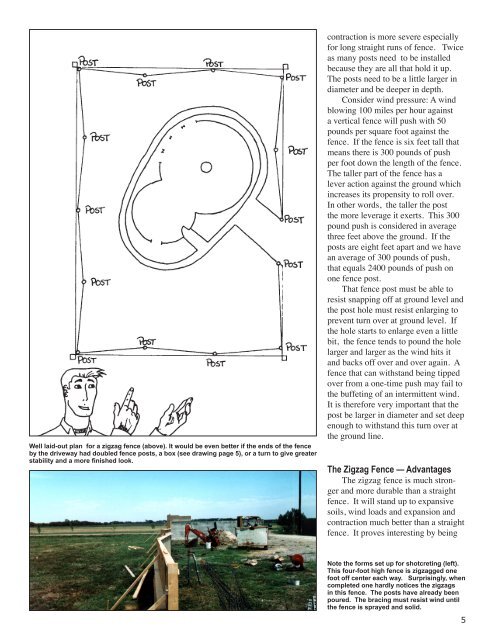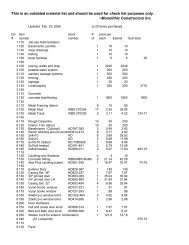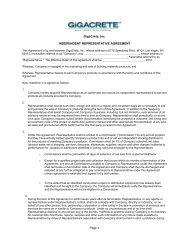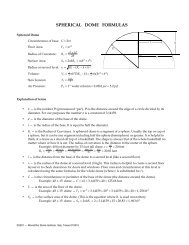How To Build A Spray-In-Place Concrete Fence - Monolithic
How To Build A Spray-In-Place Concrete Fence - Monolithic
How To Build A Spray-In-Place Concrete Fence - Monolithic
Create successful ePaper yourself
Turn your PDF publications into a flip-book with our unique Google optimized e-Paper software.
Well laid-out plan for a zigzag fence (above). It would be even better if the ends of the fence<br />
by the driveway had doubled fence posts, a box (see drawing page 5), or a turn to give greater<br />
stability and a more finished look.<br />
contraction is more severe especially<br />
for long straight runs of fence. Twice<br />
as many posts need to be installed<br />
because they are all that hold it up.<br />
The posts need to be a little larger in<br />
diameter and be deeper in depth.<br />
Consider wind pressure: A wind<br />
blowing 100 miles per hour against<br />
a vertical fence will push with 50<br />
pounds per square foot against the<br />
fence. If the fence is six feet tall that<br />
means there is 300 pounds of push<br />
per foot down the length of the fence.<br />
The taller part of the fence has a<br />
lever action against the ground which<br />
increases its propensity to roll over.<br />
<strong>In</strong> other words, the taller the post<br />
the more leverage it exerts. This 300<br />
pound push is considered in average<br />
three feet above the ground. If the<br />
posts are eight feet apart and we have<br />
an average of 300 pounds of push,<br />
that equals 2400 pounds of push on<br />
one fence post.<br />
That fence post must be able to<br />
resist snapping off at ground level and<br />
the post hole must resist enlarging to<br />
prevent turn over at ground level. If<br />
the hole starts to enlarge even a little<br />
bit, the fence tends to pound the hole<br />
larger and larger as the wind hits it<br />
and backs off over and over again. A<br />
fence that can withstand being tipped<br />
over from a one-time push may fail to<br />
the buffeting of an intermittent wind.<br />
It is therefore very important that the<br />
post be larger in diameter and set deep<br />
enough to withstand this turn over at<br />
the ground line.<br />
The Zigzag <strong>Fence</strong> — Advantages<br />
The zigzag fence is much stronger<br />
and more durable than a straight<br />
fence. It will stand up to expansive<br />
soils, wind loads and expansion and<br />
contraction much better than a straight<br />
fence. It proves interesting by being<br />
Note the forms set up for shotcreting (left).<br />
This four-foot high fence is zigzagged one<br />
foot off center each way. Surprisingly, when<br />
completed one hardly notices the zigzags<br />
in this fence. The posts have already been<br />
poured. The bracing must resist wind until<br />
the fence is sprayed and solid.<br />
5












